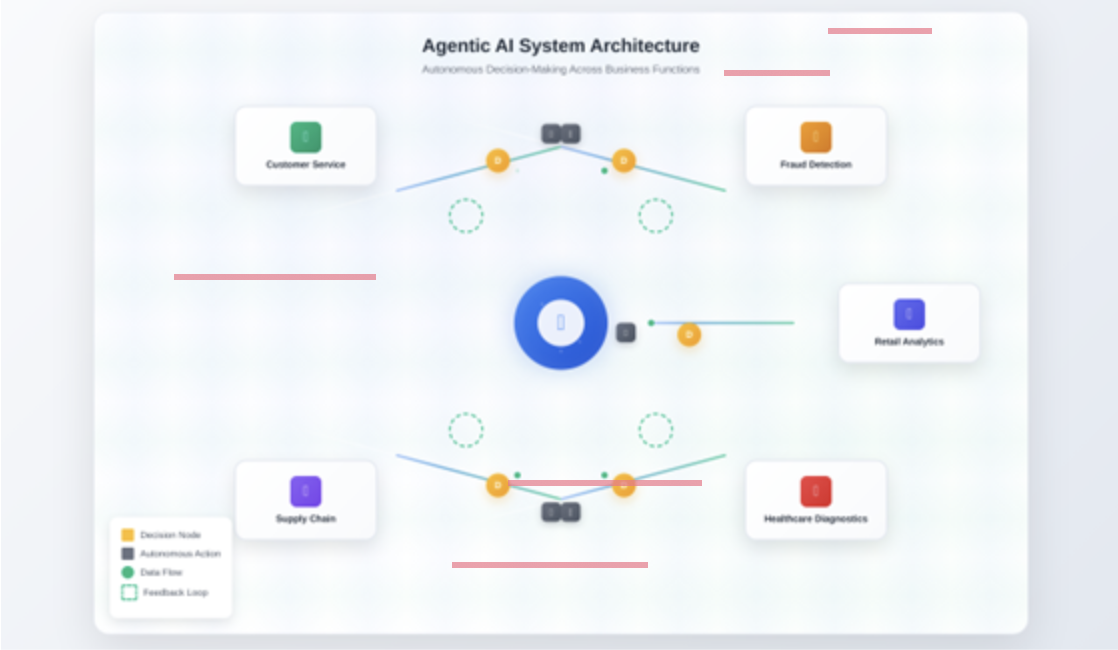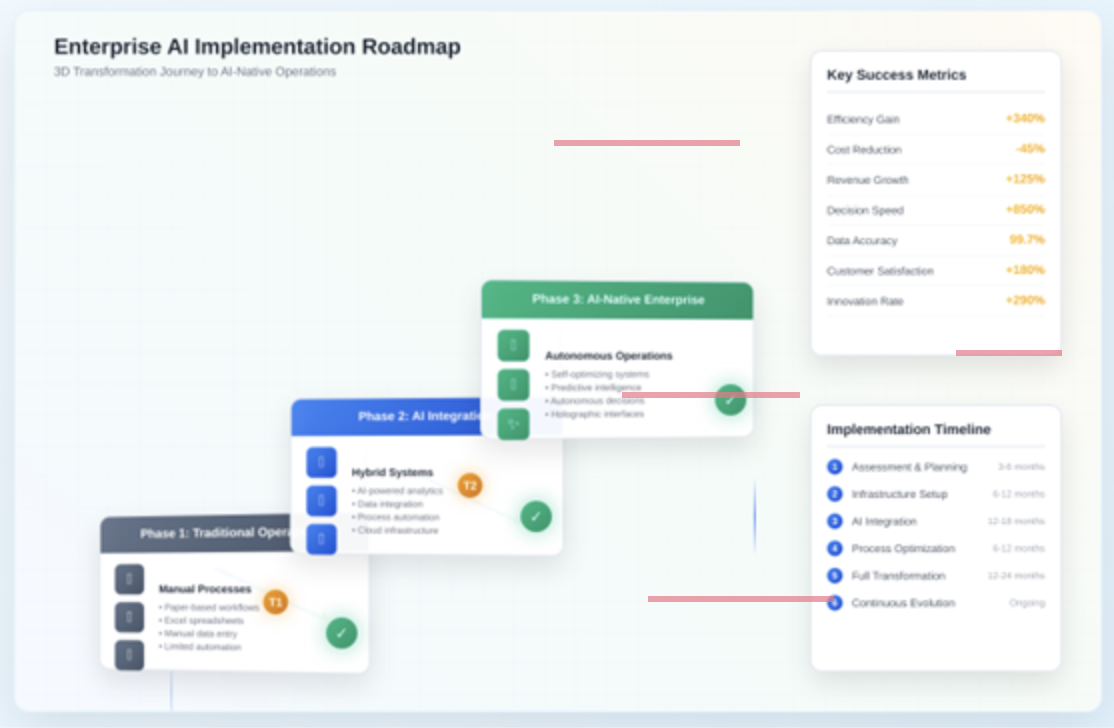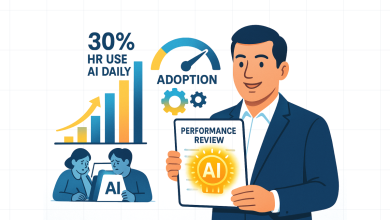
Executive Summary
In 2025, enterprise AI adoption has reached a critical inflection point. While 87% of C-suite executives report AI as a strategic priority, only 23% have achieved meaningful enterprise-wide implementation [1]. This gap—what I term the “AI Implementation Paradox”—represents the defining challenge and opportunity of our time. Organizations that resolve this paradox in 2025 will capture market leadership for the next decade [2].
A Fortune 500 CEO recently confided to me: “We’ve spent $50 million on AI initiatives, hired top talent, and launched a dozen pilot projects. Yet our competitors are somehow moving faster with less investment. What are we missing?”
The answer lies in understanding the AI Implementation Paradox—the growing chasm between AI’s extraordinary potential and the messy reality of enterprise deployment. After analyzing over 500 enterprise AI initiatives across industries, a stark pattern emerges: organizations are trapped between the urgent need to adopt AI and the overwhelming complexity of implementing it successfully.
This isn’t merely a technology challenge—it’s an existential business imperative. McKinsey’s latest research reveals that early AI adopters are already capturing 15-25% operational efficiency gains, while laggards face mounting competitive disadvantages that compound quarterly [3]. The window for strategic positioning is closing rapidly, and 2025 represents the last opportunity for many organizations to establish AI leadership in their markets [4].
The Emergence of Agentic AI: Beyond Automation to Intelligence
The most significant trend reshaping enterprise AI is the rise of agentic AI—systems that don’t just respond to commands but proactively identify opportunities, make decisions, and execute actions with minimal human intervention. Unlike traditional AI tools that require constant human guidance, agentic AI operates with sophisticated reasoning capabilities, learning from environmental feedback and adapting strategies in real-time.
Consider the transformation happening in customer service centers. Traditional chatbots follow scripted responses, but agentic AI agents can analyze customer emotions, predict needs, access multiple data sources, and even escalate issues before customers realize they have a problem. These systems aren’t just processing requests—they’re building relationships and creating value independently.
The implications for enterprise operations are staggering. In financial services, agentic AI systems are revolutionizing fraud detection by not only identifying suspicious patterns but proactively adjusting security measures and even predicting potential fraud vectors before they manifest [5]. One major bank reported a 78% reduction in false positives and a 45% improvement in actual fraud detection rates after implementing agentic AI systems [6].
But here’s where the paradox intensifies: while agentic AI offers unprecedented capabilities, it requires fundamental organizational restructuring. Companies must shift from task-oriented AI implementation to creating AI-native operational frameworks. This isn’t a software upgrade—it’s an organizational evolution.
Agentic AI System Architecture: Multi-Function Enterprise Integration
The Remote Work Catalyst: AI as the Great Equalizer
The permanent shift to hybrid and remote work has created an unexpected catalyst for AI adoption. Organizations struggling with distributed workforce management are discovering that AI isn’t just supporting remote work—it’s making it superior to traditional office-based operations.
Remote contact centers exemplify this transformation. Where traditional call centers relied on physical supervision and location-based resources, AI-powered remote operations achieve higher efficiency, better customer satisfaction, and improved agent performance. AI systems can analyze call patterns, provide real-time coaching, predict customer needs, and even adjust agent schedules based on performance algorithms and customer demand forecasting.
The paradox here is profound: while remote work initially seemed to complicate business operations, AI has made it simpler and more effective than ever before. Companies like ServiceNow and Salesforce report that their AI-enhanced remote customer service operations outperform their previous in-office metrics by 25-40% across key performance indicators [7].
This trend extends beyond customer service. AI-powered project management tools are enabling distributed teams to coordinate complex initiatives with precision that surpasses traditional in-person management. Virtual AI assistants schedule meetings across time zones, predict project bottlenecks, and automatically reallocate resources based on changing priorities.
Yet many organizations remain trapped in outdated thinking, trying to apply traditional management approaches to AI-enhanced remote operations. The successful companies are those that recognize AI as a fundamental enabler of new organizational structures, not just a digital overlay on existing processes.
Sectoral AI Transformation: From Healthcare to Retail Revolution
The breadth of AI transformation across industries in 2025 reveals both the technology’s maturity and the implementation challenges organizations face. Each sector presents unique opportunities and obstacles that collectively illustrate the AI implementation paradox.
Healthcare’s AI Renaissance
Healthcare AI has evolved beyond diagnostic assistance to comprehensive workflow transformation. General practitioners now work alongside AI systems that analyze patient data, predict health trajectories, and recommend personalized treatment plans [8]. The Royal College of General Practitioners reports that AI-assisted consultations are 35% more accurate in diagnosis and 50% more efficient in treatment planning [9].
But healthcare AI implementation faces unique regulatory and ethical challenges. Data privacy concerns, liability questions, and the need for explainable AI decisions create implementation complexities that many healthcare organizations struggle to navigate. The most successful implementations focus on AI as an augmentation tool rather than a replacement, maintaining human oversight while leveraging AI’s analytical capabilities.
Construction’s Digital Awakening
The construction industry, traditionally resistant to technological change, is experiencing a remarkable AI transformation. Project timeline optimization, resource allocation algorithms, and safety compliance monitoring are revolutionizing project management. AI systems can now predict equipment failures, optimize material deliveries, and even adjust project schedules based on weather forecasts and supplier reliability data.
One major construction firm reported reducing project delays by 60% and improving safety compliance by 80% through AI implementation [10]. However, the industry faces significant challenges in workforce adaptation and data standardization that highlight the implementation paradox.
Retail’s Personalization Revolution
Retail AI has progressed far beyond recommendation engines to comprehensive customer experience orchestration. Modern AI systems analyze shopping behaviors, predict trends, optimize inventory, and create personalized experiences across all customer touchpoints. The result is a level of customer understanding and service customization that was impossible just two years ago.
Leading retailers are achieving 25-35% improvements in customer satisfaction and 20-30% increases in average order values through AI-powered personalization [11]. Yet many retailers struggle with the organizational changes required to fully leverage these capabilities, particularly in integrating AI insights with human decision-making processes [12].
The Security Imperative: From Cybersecurity to Cyber Resilience
The evolution from cybersecurity to cyber resilience represents one of the most critical AI applications for enterprise success. Traditional cybersecurity focuses on preventing attacks, while cyber resilience emphasizes rapid detection, response, and recovery through AI-powered systems.
Modern AI security systems don’t just detect threats—they predict them, automatically adjust defenses, and orchestrate response strategies across entire organizational networks. These systems can identify potential vulnerabilities before they’re exploited, predict attack vectors based on global threat intelligence, and even simulate attack scenarios to test organizational readiness.
The financial impact is substantial. Organizations with AI-powered cyber resilience report 70% faster threat detection, 50% reduction in security incident costs, and 90% improvement in recovery times [13]. However, implementing these systems requires fundamental changes in security culture and operations that many organizations find challenging [14].
Enterprise AI Implementation Roadmap: Traditional to AI-Native Transformation
The Workforce Transformation Challenge
Perhaps the most significant aspect of the AI implementation paradox lies in workforce transformation. While AI promises to augment human capabilities and create new job categories, the transition period requires unprecedented organizational change management.
The most successful AI implementations focus on reskilling rather than replacing. Organizations are discovering that AI adoption success correlates directly with workforce adaptation programs. Companies investing in comprehensive AI literacy training report 40% higher AI project success rates and 60% better employee satisfaction during AI transitions [15].
However, this creates a complex implementation challenge. Organizations must simultaneously deploy new AI technologies, retrain existing workforce, hire AI-capable talent, and maintain operational continuity. The companies succeeding at this multifaceted challenge are those that treat workforce transformation as a strategic AI enablement initiative rather than a separate HR concern.
Financial Services: The AI Fraud Detection Revolution
The financial sector’s AI adoption provides perhaps the clearest example of both AI’s transformative potential and implementation complexity. Modern AI fraud detection systems process thousands of variables in real-time, identifying suspicious patterns that would be impossible for human analysts to detect.
These systems don’t just flag potential fraud—they predict it, automatically adjust risk parameters, and even take preventive actions like temporarily freezing suspicious transactions while alerting human oversight. The results are remarkable: major financial institutions report fraud detection accuracy improvements of 85% and false positive reductions of 70% [16].
Yet implementing these systems requires complete integration with existing financial infrastructure, regulatory compliance frameworks, and customer experience standards. The most successful implementations treat AI fraud detection as a comprehensive operational transformation rather than a technology deployment.
The Consulting Industry’s AI Reinvention
Management consulting, long considered a human-centric industry, is being fundamentally transformed by AI. Modern AI systems can analyze business problems, research industry best practices, and even generate strategic recommendations. This isn’t replacing consultants—it’s enabling them to focus on higher-value strategic thinking and client relationship management.
Leading consulting firms report that AI-augmented consultants deliver projects 40% faster with 60% more comprehensive analysis [17]. However, this transformation requires fundamental changes in consultant training, client engagement models, and service delivery approaches [18].
The Implementation Blueprint: How Leading Organizations Solve the Paradox
Analysis of successful enterprise AI implementations reveals four critical success factors that separate AI leaders from strugglers:
- The 90-Day Leadership Commitment Protocol
Top-performing organizations establish what I call the “90-Day AI Commitment Protocol.” CEOs personally lead three 90-day sprints: first, establishing AI governance frameworks; second, securing initial wins that demonstrate tangible ROI; third, scaling successful pilots enterprise-wide. This approach ensures leadership accountability while building organizational confidence.
Action Item: CEOs should personally own AI metrics in their quarterly board presentations, treating AI performance as seriously as financial metrics.
- The Data Infrastructure Imperative
Organizations with mature data infrastructure achieve 3x higher AI implementation success rates and 40% faster time-to-value. However, 67% of enterprises attempt AI deployment before addressing fundamental data quality issues—a primary cause of implementation failure [19].
Action Item: Conduct a 30-day data readiness assessment before any major AI investment. If data infrastructure scores below 7/10, pause AI initiatives to fix foundational issues first.
- The Pilot-to-Production Framework
Successful organizations follow a disciplined “3-6-12” methodology: 3 months for high-impact pilot projects, 6 months for systematic scaling, and 12 months for enterprise-wide institutionalization. This timeline prevents the common trap of perpetual piloting while ensuring thorough validation.
Action Item: Establish hard deadlines for pilot-to-production decisions. If a pilot doesn’t demonstrate clear ROI within 90 days, kill it immediately and reallocate resources.
- Human-AI Integration Strategy
Leading organizations redesign work around human-AI collaboration rather than simply adding AI to existing processes. This requires new performance metrics, revised job descriptions, and compensation structures that reward AI-augmented productivity.
Action Item: Create “AI transformation teams” that include HR, IT, and business operations to redesign workflows for optimal human-AI collaboration.
The Competitive Advantage Window
The AI implementation paradox creates a unique competitive opportunity. While many organizations struggle with implementation complexity, those that master AI deployment in 2025 will establish advantages that become increasingly difficult for competitors to overcome.
Early AI adopters are already seeing compound benefits. Their AI systems improve with more data and usage, their workforce becomes more AI-capable, and their operational efficiency gains fund additional AI investments. This creates a virtuous cycle that accelerates competitive differentiation.
Conversely, organizations that delay AI implementation face increasing disadvantages. As AI capabilities become standard in their industries, late adopters must compete against AI-enhanced competitors while simultaneously managing their own AI transformation.
Regulatory Landscape and Compliance Considerations
The evolving AI regulatory environment adds another layer to the implementation paradox. Organizations must deploy AI systems that comply with emerging regulations while delivering competitive advantages. This requires implementation strategies that build in compliance from the foundation rather than retrofitting regulatory requirements.
The European Union’s AI Act, emerging US federal AI guidelines, and sector-specific regulations create a complex compliance landscape. Organizations that proactively address regulatory requirements in their AI implementations avoid costly retrofitting and gain competitive advantages through compliant-by-design AI systems.
The Financial Reality: AI ROI Benchmarks for 2025
C-suite executives increasingly demand concrete financial justification for AI investments. Based on comprehensive analysis of enterprise AI deployments, clear ROI patterns have emerged:
Year 1 Performance Benchmarks: – Operational Efficiency: 15-25% improvement in process speed – Cost Reduction: 10-20% decrease in operational expenses – Revenue Enhancement: 5-15% increase through improved customer experience – Risk Mitigation: 30-50% reduction in compliance violations and security incidents
Break-Even Timeline: Organizations following best practices achieve ROI break-even within 8-14 months, with full investment recovery typically occurring by month 18.
Investment Allocation Framework: – 40% on data infrastructure and integration – 30% on talent acquisition and training – 20% on AI technology and platforms – 10% on change management and governance
Organizations deviating significantly from this allocation framework experience 60% higher failure rates and 40% longer implementation timelines [20].
Looking Forward: The AI-Native Enterprise
The ultimate resolution to the AI implementation paradox lies in becoming an AI-native enterprise—an organization designed from the ground up to leverage AI capabilities across all operations. This transformation goes beyond implementing AI tools to creating organizational structures, cultures, and processes that inherently incorporate AI intelligence.
AI-native enterprises don’t just use AI; they think with AI. Decision-making processes incorporate AI insights automatically, operational workflows are designed for human-AI collaboration, and strategic planning assumes AI capability enhancement over time.
Key Takeaways for C-Suite Leaders
- The Paradox is Real: 87% of executives prioritize AI, but only 23% achieve enterprise-wide success
- 2025 is Critical: This is the last opportunity for many organizations to establish AI market leadership
- ROI is Achievable: Best practices deliver 15-25% efficiency gains and 8-14 month payback periods
- Leadership Matters: CEO-driven 90-day protocols achieve 3x higher success rates
- Foundation First: Data infrastructure quality determines implementation success more than technology choice
- Action Required: 30-day implementation plans prevent competitors from establishing insurmountable advantages
Your 30-Day AI Leadership Action Plan
The AI implementation paradox of 2025 demands immediate, decisive action. Organizations that successfully navigate this complexity will establish competitive advantages that compound over time, while those that hesitate face mounting disadvantages that may prove insurmountable.
Week 1: Assessment and Alignment – Conduct an honest assessment of your organization’s AI readiness using the benchmarks outlined above – Align C-suite leadership on AI investment priorities and success metrics – Identify the top three business processes where AI could deliver immediate ROI
Week 2: Foundation Building – Launch a comprehensive data infrastructure audit – Begin recruiting AI-capable talent or partner identification – Establish an AI governance framework with clear accountability structures
Week 3: Pilot Program Launch – Select one high-impact, low-risk pilot project following the 90-day protocol – Allocate dedicated resources and remove bureaucratic obstacles – Create measurement frameworks that track both technical performance and business outcomes
Week 4: Scaling Preparation – Develop change management strategies for broader AI adoption – Begin workforce AI literacy training programs – Establish partnerships with AI technology providers and implementation specialists
The Competitive Reality
The question facing every C-suite executive isn’t whether to implement AI—it’s whether you’ll be among the organizations that master AI implementation in 2025 or join the growing ranks of companies struggling to catch up with AI-native competitors.
McKinsey projects that by 2026, organizations with successful AI implementations will capture 40-60% more market value than their traditional competitors. Conversely, companies that fail to resolve the implementation paradox risk losing 15-25% of their market position to AI-enhanced rivals [21].
The window for strategic positioning is measured in quarters, not years. The AI revolution isn’t coming—it’s here, it’s accelerating, and it’s creating permanent winners and losers in every industry.
The choice is yours. The time is now. The future belongs to those who act decisively.







